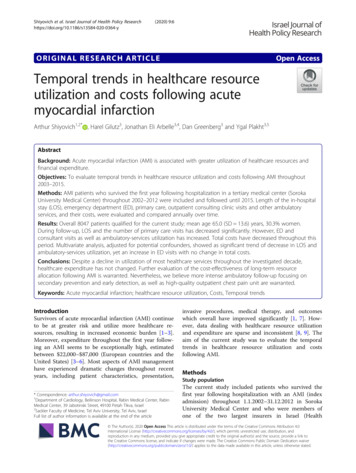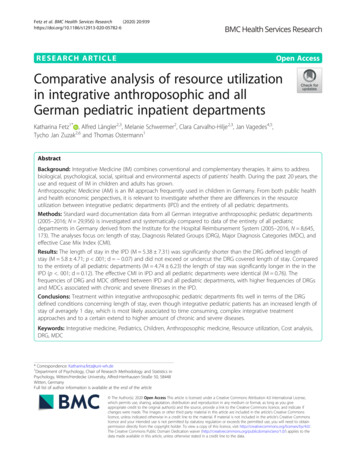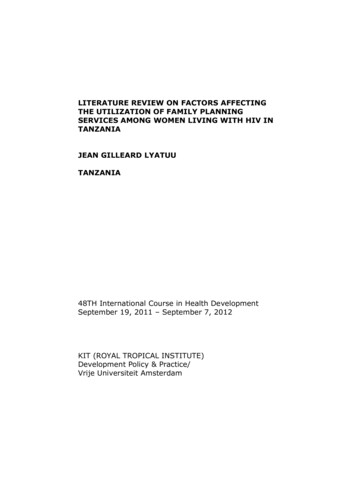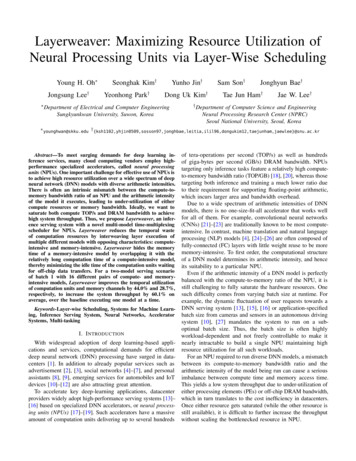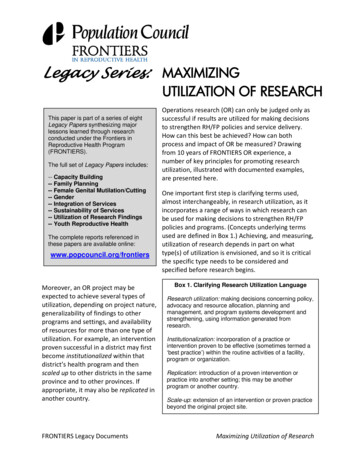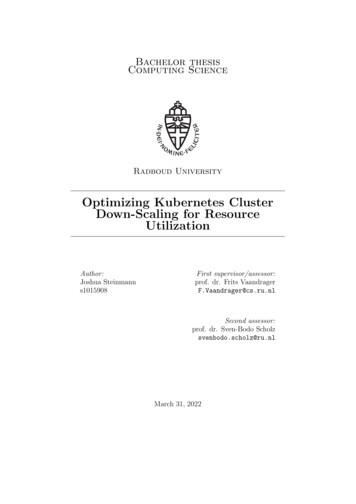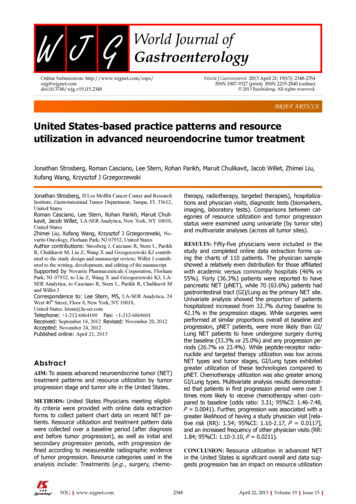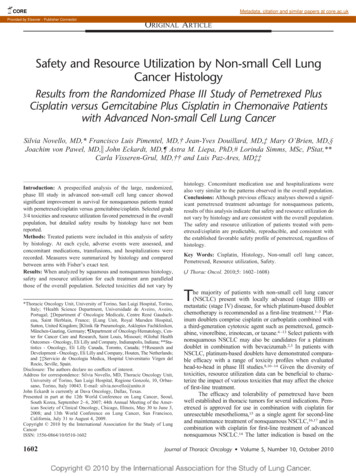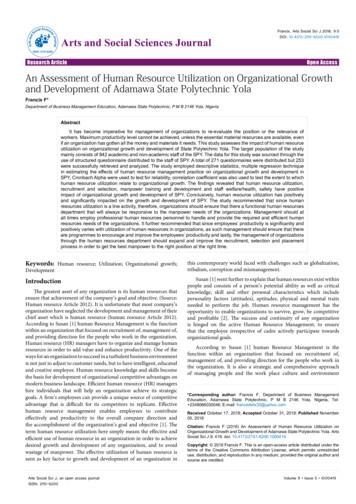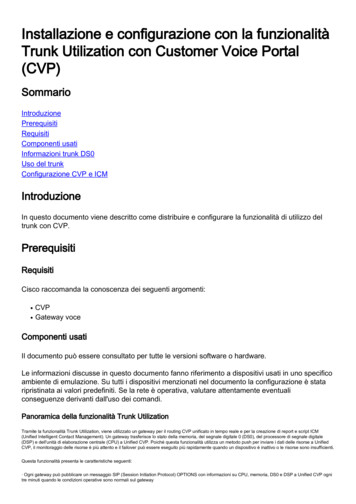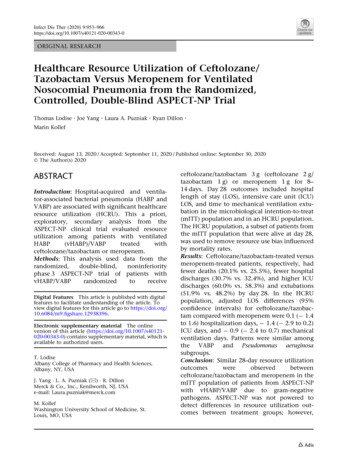
Transcription
Infect Dis Ther (2020) 3-0ORIGINAL RESEARCHHealthcare Resource Utilization of Ceftolozane/Tazobactam Versus Meropenem for VentilatedNosocomial Pneumonia from the Randomized,Controlled, Double-Blind ASPECT-NP TrialThomas Lodise . Joe Yang . Laura A. Puzniak . Ryan Dillon .Marin KollefReceived: August 13, 2020 / Accepted: September 11, 2020 / Published online: September 30, 2020Ó The Author(s) 2020ABSTRACTIntroduction: Hospital-acquired and ventilator-associated bacterial pneumonia (HABP andVABP) are associated with significant healthcareresource utilization (HCRU). This a priori,exploratory, secondary analysis from theASPECT-NP clinical trial evaluated resourceutilization among patients with azobactam or meropenem.Methods: This analysis used data from therandomized,double-blind,noninferiorityphase 3 ASPECT-NP trial of patients withvHABP/VABPrandomizedtoreceiveDigital Features This article is published with digitalfeatures to facilitate understanding of the article. Toview digital features for this article go to ronic supplementary material The onlineversion of this article (https://doi.org/10.1007/s40121020-00343-0) contains supplementary material, which isavailable to authorized users.T. LodiseAlbany College of Pharmacy and Health Sciences,Albany, NY, USAJ. Yang L. A. Puzniak (&) R. DillonMerck & Co., Inc., Kenilworth, NJ, USAe-mail: Laura.puzniak@merck.comM. KollefWashington University School of Medicine, St.Louis, MO, USAceftolozane/tazobactam 3 g (ceftolozane 2 g/tazobactam 1 g) or meropenem 1 g for 8–14 days. Day 28 outcomes included hospitallength of stay (LOS), intensive care unit (ICU)LOS, and time to mechanical ventilation extubation in the microbiological intention-to-treat(mITT) population and in an HCRU population.The HCRU population, a subset of patients fromthe mITT population that were alive at day 28,was used to remove resource use bias influencedby mortality rates.Results: Ceftolozane/tazobactam-treated versusmeropenem-treated patients, respectively, hadfewer deaths (20.1% vs. 25.5%), fewer hospitaldischarges (30.7% vs. 32.4%), and higher ICUdischarges (60.0% vs. 58.3%) and extubations(51.9% vs. 48.2%) by day 28. In the HCRUpopulation, adjusted LOS differences (95%confidence intervals) for ceftolozane/tazobactam compared with meropenem were 0.1 (- 1.4to 1.6) hospitalization days, - 1.4 (- 2.9 to 0.2)ICU days, and - 0.9 (- 2.4 to 0.7) mechanicalventilation days. Patterns were similar amongthe VABP and Pseudomonas aeruginosasubgroups.Conclusion: Similar 28-day resource tazobactam and meropenem in themITT population of patients from ASPECT-NPwith vHABP/VABP due to gram-negativepathogens. ASPECT-NP was not powered todetect differences in resource utilization outcomes between treatment groups; however,
Infect Dis Ther (2020) 9:953–966954numerical differences in ICU LOS and durationof mechanical ventilation were noted. Furtherstudy is needed to assess resource utilization inthe real-world practice setting, especiallyamong patients excluded from ASPECT-NP,including those with resistant P. aeruginosainfections.Trial Registrations: ClinicalTrials.gov: NCT02070757, registered February 25, 2014; EudraCT:2012-002862-11.Keywords: Ceftolozane/tazobactam; Hospitalacquired bacterial pneumonia; Hospitalization;Mechanical ventilation; Meropenem; Multidrugresistance; Pseudomonas aeruginosa; Ventilatorassociated bacterial pneumoniaDIGITAL FEATURESThis article is published with digital features tofacilitate understanding of the article. To viewthe digital features for this article go to https://doi.org/10.6084/m9.figshare.12938396.Key Summary PointsWhy carry out this study?Hospital-acquired and ventilatorassociated bacterial pneumonia (HABPand VABP) are associated with significanthealthcare resource utilization.In this exploratory secondary analysis ofthe ASPECT-NP noninferiority registrationtrial, we hypothesized that participantstreated with ceftolozane/tazobactam ormeropenem would have similar resourceutilization.What was learned from the study?Similar 28-day HCRU outcomes wereobserved between ceftolozane/tazobactamand meropenem in the microbiologicalintention-to-treat (mITT) population ofparticipants with ventilated HABP(vHABP) or VABP due to gram-negativepathogens.Although ASPECT-NP was a noninferioritystudy and not powered to detectdifferences in outcomes betweentreatment groups, there were numericaldifferences in resource utilizationoutcomes, specifically for intensive careunit (ICU) hospital length of stay (LOS)and duration of mechanical ventilation.If a reduction of these costly resources(ICU days and mechanical ventilation)can be realized in a real-world setting, theuse of ceftolozane/tazobactam couldpotentially minimize the economicburden associated with the managementof patients with VABP or vHABP due togram-negative pathogens. Furtherevaluations of resource utilizationespecially in key subpopulations areneeded.INTRODUCTIONHospital-acquired bacterial pneumonia (HABP)and ventilator-associated bacterial pneumonia(VABP) are infections of the lower respiratorytract that occur after at least 48 h of hospitalization or mechanical ventilation, respectively[1]. Although regional variation exists, Pseudomonas aeruginosa is the leading gram-negativepathogen responsible for HABP/VABP in theUSA, Europe, and Latin America, followed byEnterobacterales (mainly Escherichia coli andKlebsiella spp.) [2–4]. HABP and VABP are bothassociated with significant healthcare resourceutilization (HCRU), morbidity, and mortality[5, 6]. The attributable mortality of nosocomialpneumonia is high, with rates ranging from20% to 55% [1, 7–10]. A US national databasestudy evaluated the economic burden, as measured by median hospitalization cost and hospital length of stay (LOS), for patients withcommunity-acquired pneumonia, healthcareassociated pneumonia, HABP, and VABP. Thehighest median cost ( 64,639; interquartilerange [IQR], 36,979– 108,391) and longestmedian LOS (21 days; IQR, 13–33 days) wereamong patients with VABP, followed by
Infect Dis Ther (2020) 9:953–966patients with HABP at a median cost of 27,422(IQR, 15,075– 52,469) and a median LOS of14 days (IQR, 9–22 days). These hospital-acquired infections have a greater economic burden compared with patients with healthcareassociated pneumonia, at a median cost of 16,505 (IQR, 8706– 32,681) and a medianLOS of 9 days (IQR, 6–15 days), and community-acquired pneumonia, with the lowest costat 11,440 (IQR, 6345– 23,352) and theshortest LOS of 7 days (IQR, 5–12 days). Thishierarchical economic burden remained evenafter adjusting for age and disease severity [11].The burden of HABP/VABP is further complicated by the increased ubiquity of eptibility to available first-line empirictreatments has diminished over time [13].Patients with serious infections due to antibacterial-resistant pathogens have considerablyworse outcomes relative to their susceptiblecounterparts [14]. In a US national databasestudy,patientswithmultidrug-resistantP. aeruginosa respiratory infections had highermortality, an approximately 7-day longer LOS, 20,000 excess costs, higher readmission rates,and more than 10,000 excess net loss per casefor the hospital relative to those with nonmultidrug-resistant P. aeruginosa infections [15].Infections caused by antibacterial-resistantpathogens also increase the likelihood that apatient will not receive a microbiologicallyactive antibacterial agent for several days afterinfection onset [16–18], further exacerbatingthe deleterious outcomes observed amongpatients with antibacterial-resistant infections[19].Ceftolozane/tazobactam is a novel combination of ceftolozane, a potent antipseudomonal cephalosporin, and tazobactam, ab-lactamase inhibitor [20–22]. Ceftolozane/tazobactam has demonstrated in vitro activityagainst many pathogens that cause nosocomialpneumonia,includingmultidrug-resistantP. aeruginosa and extended-spectrum b-lactamase-producing Enterobacterales [23], and wasrecently approved by the US Food and DrugAdministration and European MedicinesAgency for the treatment of adult patients withHABP and VABP due to gram-negative955pathogens [22]. These approvals were based onthe randomized, controlled, double-blind,phase 3 noninferiority ASPECT-NP (nosocomialpneumonia) trial, conducted at 263 hospitals in34 countries, that established the efficacy andsafety of ceftolozane/tazobactam 3 g (ceftolozane 2 g/tazobactam 1 g) relative to meropenem1 g for patients with VABP or ventilated HABP(vHABP). In ASPECT-NP, day 28 all-cause mortality (primary endpoint) and clinical responseat the test-of-cure visit (key secondary efficacyendpoint) were similar between treatmentgroups, and noninferiority was demonstratedfor both endpoints [24].While these endpoints provide criticalinformation on the safety and efficacy ofceftolozane/tazobactam, it is also crucial toevaluate the impact of new treatment modalities on the quality and efficiency of healthcaredelivery. The emphasis on efficiency is alsocongruent with antibacterial stewardship effortsin the hospital setting, which seek to improvepatient outcomes, reduce the development ofantimicrobial resistance, and minimize unnecessary costs without negatively impactingquality of care [25]. Given the increased focuson value and efficiency of care across healthcaresystems worldwide, an a priori secondaryexploratory analysis was included in theASPECT-NP protocol to evaluate the differencesin hospital LOS, intensive care unit (ICU) LOS,and duration of mechanical ventilationbetween patients treated with ceftolozane/tazobactam or meropenem. Although this studywas not powered to detect differences betweentreatment groups, we anticipated that patientstreated with ceftolozane/tazobactam or meropenem would have similar resource utilizationin this secondary exploratory analysis due tothe ASPECT-NP study meeting its noninferiorityendpoint.METHODSStudy DesignThis a priori, secondary, exploratory resourceutilization analysis was based on data from therandomized,double-blind,noninferiority
Infect Dis Ther (2020) 9:953–966956phase 3 ASPECT-NP trial of patients at least18 years of age with VABP or vHABP. Details oninclusion and exclusion criteria of the randomized controlled trial are described elsewhere[24] and listed in the supplemental e/tazobactam 3 g (ceftolozane 2 g andtazobactam 1 g) or meropenem 1 g via 1-hintravenous infusion every 8 h for 8–14 days.Treatment duration was at the investigator’sdiscretion, although a minimum of 14 days oftherapy was recommended for patients withP. aeruginosa infection. Patients were stratifiedby the study design into VABP or vHABP groups.The VABP group required the addition of atleast 48 h of mechanical ventilation and eitheracute changes in ventilator support to enhanceoxygenation or the presence of hypoxemiabefore the infection. The vHABP group requiredhospitalization for at least 48 h (or previousdischarge within the past 7 days) and had atleast one of the following criteria within 24 hbefore intubation or within 48 h after intubation: worsening cough, tachypnea, dyspnea,respiratory rate greater than 30 breaths perminute, and/or hypoxemia [24]. The ASPECTNP study was conducted in accordance with theprinciples of the Declaration of Helsinki andwas approved by the appropriate institutionalreview boards and regulatory agencies. Allpatients or legally acceptable representativesprovided informed consent.Resource Utilization OutcomesResource utilization metrics analyzed in thisstudy were the proportion of patients that weredischarged from the hospital, discharged fromthe ICU, or extubated within 28 days of randomization, along with hospital/ICU LOS andduration of mechanical ventilation. Resourceutilization duration was measured as the number of days between the date of randomizationand either the date of resource utilization termination (i.e., hospital discharge, ICU discharge among patients in the ICU at baseline,and extubation) or the date of truncation (deathor day 28, whichever came first). Althoughthere were patients who exceeded a 28-day staywithin the trial, the 28-day endpoint was chosen to align with the trial’s primary and secondary efficacy endpoints and because followup beyond 28 days was variable.Analysis PopulationsThis analysis included two study populations:the microbiological intention-to-treat (mITT)population and the HCRU population. ThemITT population included patients whoreceived any amount of study drug and had atleast one bacterial respiratory pathogen (excluding Staphylococcus aureus) isolated from thebaseline lower respiratory tract culture that wassusceptible to at least one of the study drugs.The mITT population (n 511) was a subset ofthe intention-to-treat population (n 726) andwas chosen as the main analysis population toassess resource utilization because it requiredreceipt of the study drugs and a pathogenagainst which the study drugs were active. TheHCRU population was a subset of the mITTpopulation and comprised patients who werealive at day 28 and achieved the outcome ofinterest by day 28 (i.e., hospital discharge, ICUdischarge among patients in the ICU at baseline, and extubation). The HCRU populationwas created to mitigate the influence of deathon resource utilization. The high mortality rateseen in vHABP and VABP can bias the true effectof resource utilization because patients who dietend to have a much shorter LOS relative tothose who do not. Because the HCRU population is dependent on outcome of interest, thesample size varies by outcome. For example, theHCRU population for hospital discharge is lessthan one-third of the mITT population.Statistical AnalysisWe report the numbers and percentages ofpatient characteristics, the proportion ofpatients that achieved each outcome of interest(i.e., hospital discharge, ICU discharge amongpatients in the ICU at baseline, and extubation)by day 28 after enrollment, and the duration ofresource utilization including number ofpatients, arithmetic mean, and standard
Infect Dis Ther (2020) 9:953–966deviation (SD). To address possible imbalancesin characteristics of discharged/extubatedpatients in the two groups, we used the generalized linear model (GLM) to calculate adjusteddifferences in LOS. The GLM is a preferred statistical method for LOS analyses where skewnessand truncation are often present [26–28]. Weused the GLMs with log-link function and tested three residual distributions, namely gamma,negative binomial, and Poisson. The selectionbetween the residual distributions was made byanalyzing the scale parameter to determine thepresence of overdispersion [29]. In the total 24GLM regressions, overdispersion (i.e., scaleparameter [ 1.0) was detected in 20 regressions,suggesting that the negative binomial was themost appropriate distribution specification.Covariates in the GLMs included age (\ 65 vs.C 65 years), sex, baseline Acute Physiology andChronic Health Evaluation II score (\ 20 orC 20), baseline pathogen type (P. aeruginosa vs.Enterobacterales), infection type (polymicrobialvs. monomicrobial), pneumonia type (vHABPvs. VABP), country of treatment, prior antibacterial failure, bacteremia, comorbidities (diabetes, congestive heart failure, chronicobstructive pulmonary disease, emphysema,and pleural effusion), and log-transformed prerandomization resource utilization duration ofthe corresponding resource type (e.g., for ICULOS, pre-randomization ICU stay was used).Selection of covariates was based on clinicalmeaningfulness and relevancy. We did notimplement any variable selection procedurebased on predictive power, which is often usedfor outcome prediction but not for effectestimation. The average LOS differenceattributable to treatment was calculated as thedifference in least-squares means between thetwo treatment groups. All statistical analyseswere conducted using SAS version 9.4 (SASInstitute, Inc., Cary, NC, USA), primarily PROCGENMOD and LIFETEST functions.RESULTSA total of 726 patients were enrolled and randomly assigned to ceftolozane/tazobactam(n 362) or meropenem (n 364). The mITT957population comprised 264 patients treated withceftolozane/tazobactam and 247 treated withmeropenem. Baseline and clinical characteristics of the mITT population were comparablebetween both treatment groups (Table 1).However, more patients who receivedceftolozane/tazobactam had prior ,n 39/264 [14.8%]; meropenem, n 24/247[9.7%]) and bacteremia (ceftolozane/tazobactam, n 43/264 [16.3%]; meropenem, n 26/247 [10.5%]) at baseline. In the mITT population, the mean (SD) duration of hospitalizationbefore randomization was 12.0 (60.4) days inthe ceftolozane/tazobactam group versus 7.0(7.0) days in the meropenem group. Mean (SD)duration of mechanical ventilation before randomization was 11.2 (26.4) days for patientstreated with ceftolozane/tazobactam versus 9.8(7.6) days for those treated with meropenem.Clinical cure was observed in 193 (73.1%)ceftolozane/tazobactam-treated patients and168 (68.0%) meropenem-treated patients in themITT population.Table 2 reports 28-day mortality and hospital/ICU discharge and mechanical ventilationextubation rates among the mITT population.Mortality within 28 days occurred in 53 (20.1%)of 264 ceftolozane/tazobactam-treated patientsand 63 (25.5%) of 247 meropenem-treatedpatients. Within 28 days, 81 (30.7%) of 264ceftolozane/tazobactam-treated patients and 80(32.4%) of 247 meropenem-treated patientswere discharged from the hospital, 153 (60.0%)of 255 ceftolozane/tazobactam-treated patientsand 140 (58.3%) of 240 meropenem-treatedpatients were discharged from the ICU, and 137(51.9%) of 264 ceftolozane/tazobactam-treatedpatients and 119 (48.2%) of 247 meropenemtreated patients were extubated.Resource utilization durations for hospitalization, ICU stay, and mechanical ventilationare shown in Table 3. In the mITT population,the patient characteristic-adjusted LOS differences (95% confidence interval [CI]) forceftolozane/tazobactam compared with meropenem were 1.1 (- 0.4 to 2.7) hospitalizationdays, - 0.6 (- 2.3 to 1.0) ICU days, and - 0.6(- 2.1 to 0.9) mechanical ventilation days. Ofnote,mortality(ceftolozane/tazobactam,
Infect Dis Ther (2020) 9:953–966958Table 1 Patient demographics and clinical characteristics of the mITT population (N 511)Ceftolozane/tazobactam(n 264)Meropenem(n 247)VABP, n (%)209 (79.2)176 (71.3)vHABP, n (%)55 (20.8)71 (28.7)\ 65152 (57.6)131 (53.0)C 65112 (42.4)116 (47.0)198 (75.0)177 (71.7)Age, years, n (%)Male sex, n (%)APACHE II score, median (IQR)17 (15–20)17 (15–21)Prior antibacterial failure, n (%)39 (14.8)24 (9.7)Bacteremia, n (%)43 (16.3)26 (10.5)Baseline P. aeruginosa pathogen, n (%)63 (23.9)65 (26.3)Duration of hospitalization before randomization, mean (SD),days12.0 (60.4)7.0 (7.0)Duration of mechanical ventilation before randomization, mean(SD), days11.2 (26.4)9.8 (7.6)APACHE II Acute Physiology and Chronic Health Evaluation II, IQR interquartile range, mITT microbiological intentionto-treat, SD standard deviation, VABP ventilator-associated bacterial pneumonia, vHABP ventilated hospital-acquiredbacterial pneumonia20.1%; meropenem, 25.1%) had an influenceon the duration of resource utilization in themITT population, as deceased patients had, onaverage, a 4-day reduction in hospital LOS and a2-day reduction in ICU LOS and time spent onmechanical ventilation. Within the HCRUpopulation in which the influence of mortalitywas removed, adjusted LOS differences (95%CIs) for ceftolozane/tazobactam compared withmeropenem were 0.1 (- 1.4 to 1.6) hospitalization days (n 161), - 1.4 (- 2.9 to 0.2) ICUdays (n 284), and - 0.9 (- 2.4 to 0.7)mechanical ventilation days (n 269).Duration of resource utilization was furtheranalyzed by subgroups of interest (Table 4). Ingeneral, the subgroup of patients with VABPand P. aeruginosa within the mITT populationshowed some numerical reductions in all threetypes of resource utilization for ceftolozane/tazobactam compared with meropenem. Similarresults were also observed in the HCRU subgroups in which patients were alive andachieved the outcome of interest by day 28.More specifically, in the HCRU populationamong patients with VABP, the adjusted LOSdifferences (95% CIs) for ceftolozane/tazobactam compared with meropenem were - 1.1(- 2.6 to 0.6) hospitalization days, - 1.5 (- 3.1to 0.3) ICU days, and - 1.3 (- 3.0 to 0.8)mechanical ventilation days; the correspondingmetrics for patients with infections due toP. aeruginosa were - 2.1 (- 5.1 to 1.8) days,- 3.0 (- 5.3 to - 0.2) days, and - 4.5 (- 8.1 to0.7) days for duration of hospitalization, ICUstay, and mechanical ventilation, respectively.However, in the vHABP subgroup within the
Infect Dis Ther (2020) 9:953–966959Table 2 Day 28 mortality and termination of hospital resource use in the mITT populationCeftolozane/tazobactam, n/N (%)Meropenem, n/N (%)Day 28—mortalitymITT totalvHABP subgroupaVABP subgroupaBaseline P. aeruginosa subgroup53/264 (20.1)63/247 (25.5)10/55 (18.2)24/71 (33.8)43/209 (20.6)36/176 (20.5)16/63 (25.4)12/65 (18.5)Day 28—patients achieving respective outcome of interestbHospital dischargemITT totalvHABP subgroupaVABP subgroupaBaseline P. aeruginosa subgroup81/264 (30.7)80/247 (32.4)20/55 (36.4)23/71 (32.4)61/209 (29.2)57/176 (32.4)18/63 (28.6)19/65 (29.2)153/255 (60.0)140/240 (58.3)33/53 (62.3)34/68 (50.0)115/202 (56.9)98/172 (57.0)35/59 (59.3)39/63 (61.9)137/264 (51.9)119/247 (48.2)35/55 (63.6)36/71 (50.7)108/209 (51.7)90/176 (51.1)34/63 (54.0)40/65 (61.5)cICU dischargemITT totalvHABP subgroupaVABP subgroupaBaseline P. aeruginosa subgroupMechanical ventilator extubationmITT totalvHABP subgroupaVABP subgroupaBaseline P. aeruginosa subgroupHCRU healthcare resource utilization, ICU intensive care unit, mITT microbiological intention-to-treat, VABP ventilatorassociated bacterial pneumonia, vHABP ventilated hospital-acquired bacterial pneumoniaaPercentage of P. aeruginosa was comparable in both VABP (n 100/385 [26%]) and vHABP (n 28/126 [22%])bPatients achieving respective outcome of interest were defined as those who were alive and experienced, respectively,hospital discharge, ICU discharge, or mechanical ventilator extubation within 28 days of enrollment. These patientsconstituted the HCRU populationcAlthough all patients were receiving mechanical ventilation, not all patients were admitted to the ICU at trial enrollmentHCRU population, differences were in a reversedirection for hospitalization days (adjusted LOSdifference, 5.7 [95% CI - 0.4 to 13.6] days) andmechanical ventilation (adjusted ventilationdifference, 0.4 [95% CI - 1.5 to 3.1] days) butsimilar for ICU stay (adjusted ICU LOS, - 1.3[95% CI - 4.8 to 3.1] days).DISCUSSIONPhase 3 international, multicenter, randomized,double-blind, comparative noninferiority clinical trials are the current gold standard forestablishing the efficacy and safety profiles ofnew antibacterial agents for the treatment of
Infect Dis Ther (2020) 9:953–966960Table 3 Duration of resource utilization for hospitalization, ICU stay, and mechanical ventilation for the overall mITTand HCRU populationsCeftolozane/tazobactam Meropenem Unadjusted difference(95% CI)Adjusted differencea(95% CI)mITT populationHospital LOS, n264247Median (IQR)28 (16–28)24 (15–28)Mean (SD)21.9 (7.6)21.1 (7.9)255240Median (IQR)16 (9–25)17 (11–25)Mean (SD)16.3 (8.5)17.0 (8.3)ICU LOS, nMechanical ventilator 264use, n0.8 (- 0.5 to 2.1)1.1 (- 0.4 to 2.7)- 0.7 (- 2.2 to 0.8)- 0.6 (- 2.3 to 1.0)- 0.5 (- 2.2 to 1.2)- 0.6 (- 2.1 to 0.9)247Median (IQR)12 (5–28)13 (6–28)Mean (SD)14.3 (10.0)14.8 (10.0)bHCRU population (patients achieving respective outcome of interest within 28 days)Hospital LOS, n8180Median (IQR)17 (14–22)17 (14–22)Mean (SD)17.8 (5.4)17.8 (5.5)148136Median (IQR)13 (9–18)15 (10–22)Mean (SD)13.3 (6.5)15.1 (6.8)ICU LOS, nMechanical ventilator 143use, n- 0.0 (- 1.7 to 1.7)0.1 (- 1.4 to 1.6)- 1.8 (- 3.3 to - 0.3)- 1.4 (- 2.9 to 0.2)- 1.1 (- 2.8 to 0.6)- 0.9 (- 2.4 to 0.7)126Median (IQR)7 (4–12)8 (3–15)Mean (SD)8.8 (6.5)9.9 (7.4)CI confidence interval, HCRU healthcare resource utilization, ICU intensive care unit, IQR interquartile range, LOS lengthof stay, mITT microbiological intention-to-treat, SD standard deviation, VABP ventilator-associated bacterial pneumonia,vHABP ventilated hospital-acquired bacterial pneumoniaaAdjusted difference is based on a generalized linear model with log-link function and negative binomial distribution.Covariates included treatment (ceftolozane/tazobactam vs. meropenem), age (\ 65 vs. C 65 years), sex (male vs. female),baseline Acute Physiology and Chronic Health Evaluation II score (\ 20 vs. C 20), pneumonia type (vHABP vs. VABP),baseline pathogen type (P. aeruginosa vs. Enterobacterales), infection type (polymicrobial vs. monomicrobial), country oftreatment, prior antibacterial failure, bacteremia, comorbidities (diabetes, congestive heart failure, chronic obstructivepulmonary disease, emphysema, and pleural effusion), and log-transformed pre-randomization resource utilization durationof the corresponding type (e.g., for total hospital LOS, pre-randomization hospital LOS was used); adjusted difference isbased on estimate of average marginal effect for ceftolozane/tazobactambPatients achieving respective outcome of interest were defined as those who were alive and experienced, respectively,hospital discharge, ICU discharge, or mechanical ventilator extubation within 28 days of enrollment. These patientsconstituted the HCRU population
Infect Dis Ther (2020) 9:953–966961Table 4 Duration of resource utilization including hospitalization, ICU stay, and mechanical ventilation for the overallmITT population and among the HCRU population (discharged patients in the mITT population)Ceftolozane/tazobactam MeropenemDifference (95% CI)Mean (SD) UnadjustedAdjustedanMean (SD)nmITT population20921.7 (7.8)176 22.1 (7.2)- 0.4 (- 1.9 to 1.1)0.2 (- 1.3 to 1.9)HCRU population6116.9 (5.1)57 18.1 (5.4)- 1.2 (- 3.1 to 0.7)- 1.1 (- 2.6 to 0.6)20216.4 (8.5)172 18.0 (8.1)- 1.6 (- 3.3 to 0.1)- 1.1 (- 2.6 to 0.7)HCRU population 11513.3 (6.4)98 15.6 (7.0)- 2.3 (- 4.1 to 0.5)- 1.5 (- 3.1 to 0.3)14.8 (10.1)176 16.3 (10.0)8.8 (6.5)90 10.7 (7.8)- 1.9 (- 3.9 to 0.1)- 1.3 (- 3.0 to 0.8)VABPHospital LOSICU LOSmITT populationMechanical ventilator usemITT population209HCRU population 108- 1.5 (- 3.5 to - 0.5) - 0.8 (- 2.5 to 1.3)vHABPHospital LOSmITT population5522.7 (7.1)71 18.6 (9.0)4.1 (1.2 to 7.0)5.2 (1.3 to 9.9)HCRU population2013.8 (7.7)23 10.5 (7.5)3.3 (- 1.4 to 8.0)5.7 (- 0.4 to 13.6)mITT population5316.1 (8.7)68 14.6 (8.4)1.5 (- 1.6 to 4.6)2.0 (- 1.2 to 6.1)HCRU population3313.2 (6.7)34 13.7 (6.3)- 0.5 (- 3.7 to 2.7)- 1.3 (- 4.8 to 3.1)71 10.8 (9.1)1.8 (- 1.5 to 5.1)3.2 (- 0.4 to 8.1)367.8 (5.9)1.1 (- 1.9 to 4.1)0.4 (- 1.5 to 3.1)ICU LOSMechanical ventilator usemITT population5512.6 (9.6)HCRU population358.9 (6.7)mITT population6321.7 (7.7)65 23.2 (7.2)- 1.5 (- 4.1 to 1.1)- 1.7 (- 4.0 to 1.0)HCRU population1818.4 (5.8)19 21.4 (4.5)- 3.0 (- 6.5 to 0.5)- 2.1 (- 5.1 to 1.8)mITT population5915.6 (8.2)63 18.5 (7.7)- 2.9 (- 5.8 to - 0.0) - 3.1 (- 5.3 to - 0.5)HCRU population3514.0 (6.8)39 18.3 (6.5)- 4.3 (- 7.3 to - 1.3) - 3.0 (- 5.3 to - 0.2)13.2 (10.0)65 14.5 (9.4)- 1.3 (- 4.7 to 2.1)Pseudomonas aeruginosaHospital LOSICU LOSMechanical ventilator usemITT population63- 2.1 (- 4.8 to 0.4)
Infect Dis Ther (2020) 9:953–966962Table 4 continuedCeftolozane/tazobactam MeropenemnHCRU population34Mean (SD)7.2 (6.3)nDifference (95% CI)Mean (SD) Unadjusted40 11.9 (7.8)Adjusteda- 4.7 (- 8.0 to - 1.4) - 4.5 (- 8.1 to 0.7)CI confidence interval, HCRU healthcare resource utilization, ICU intensive care unit, LOS length of stay, mITTmicrobiological intention-to-treat, SD standard deviation, VABP ventilator-associated bacterial pneumonia, vHABP ventilated hospital-acquired bacterial pneumoniaaAdjusted difference is based on a generalized linear model with log-link function and negative binomial distribution;covariates included treatment (ceftolozane/tazobactam vs. meropenem), age (\ 65 vs. C 65 years), sex (male vs. female),baseline Acute Physiology and Chronic Health Evaluation II score (\ 20 vs. C 20), baseline pathogen type (P. aeruginosavs. Enterobacterales), infection type (polymicrobial vs. monomicrobial), pneumonia type (vHABP vs. VABP), country oftreatment, prior antibacterial failure, bacteremia, comorbidities (diabetes, congestive heart failure, chronic obstructivepulmonary disease, emphysema, and pleural effusion), and log-transformed pre-randomization resource utilization durationof the corresponding type (e.g., for total hospital LOS, pre-randomization hospital LOS was used); adjusted difference isbased on estimate of average marginal effect for ceftolozane/tazobactamHABP/VABP. Although efficacy and safety areestablished in such a design setting for thepurposes of regulatory approval, it is challenging to infer meaningful economic or comparative effectiveness. The consideration ofeconomic endpoints and the magnitude ofthese differences is key to making value judgments [30]. Given the increased focus on valueand efficiency of care across healthcare systemsworldwide, an a priori, secondary, exploratoryanalysis was included in the ASPECT-NP protocol to evaluate the differences in hospital LOS,ICU LOS, and duration of mechanical azobactam or meropenem. Overall, similar 28-day resource utilization outcomeswere observed between ceftolozane/tazobactamand meropenem in the mITT population ofpatients from ASPECT-NP with vHABP/VABPdue to gram-negative pathogens. AlthoughASP
Resource Utilization Outcomes Resource utilization metrics analyzed in this study were the proportion of patients that were discharged from the hospital, discharged from the ICU, or extubated within 28 days of ran-domization, along with hospital/ICU LOS and duration of mechanical ventilation. Resource utilization duration was measured as the num-
